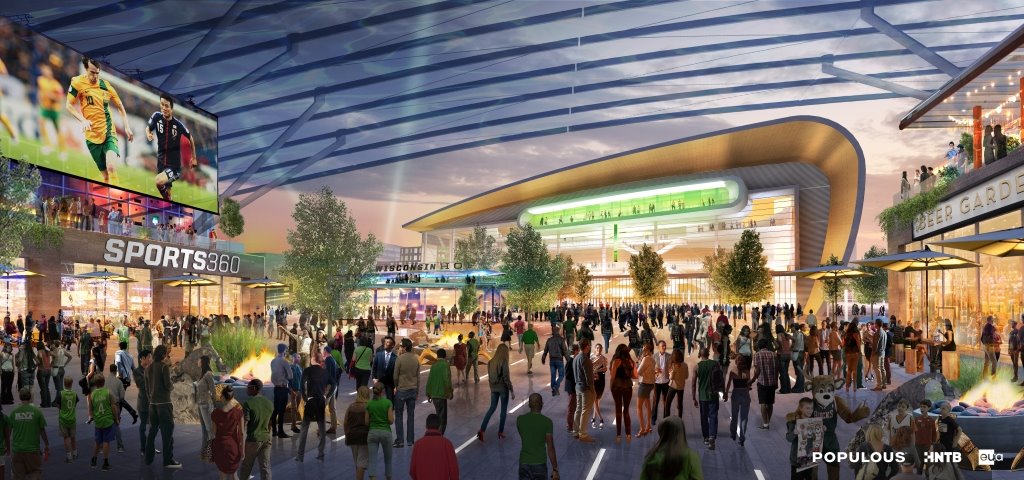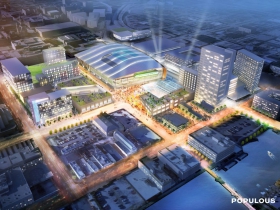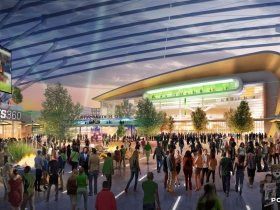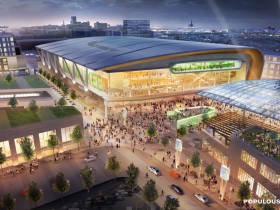Black City Residents Not Sold on NBA Arena
African American leaders who support it face skepticism from constituents.

Supporters of a new Bucks arena look forward to a revitalized business and entertainment district around the facility.
Whenever State Sen. Nikiya Harris Dodd talks in favor of the proposal to build a $500 million downtown arena that would be the new home for the Milwaukee Bucks she gets “pretty cold stares” from some of her constituents.
Ralph Hollmon, president of the Urban League, said, “Believe me, in my community I get my share of pushback and frankly some criticism” whenever he voices his organization’s support for the arena.
The arena proposal was passed by the state Assembly and has gone to Gov. Scott Walker for his signature, but it is “a highly emotional issue for everyone in the community,” according to Harris Dodd. Bucks owners and former U.S. Sen. Herb Kohl, the previous owner, will pay $250 million, or about half the initial cost for the building. The other portion is slated to come from the state, county and city. Considering interest payments over the expected 20-year life of the funding package, the total public cost would likely be about $400 million, according to reports.

State Sen. Nikiya Harris Dodd supports the new arena and thinks it will increase interest in downtown. Photo by Andrea Waxman.
Elected officials and community leaders who favor the proposal see it as an investment in the city’s future that would pay for itself, provide jobs and serve as a community asset. But controversy swirls around the public funding component and the value an NBA franchise brings to a city facing tight budgets and a range of challenges relating to poverty, crime, education and other issues.
The arena would be built in State Sen. Lena Taylor’s district (District 4) and she too has heard her share of criticism from constituents. Nonetheless, she favors the project for economic reasons. NBA players will pay more than $700 million in local taxes over the next 32 years, according to Taylor. “Revenue from the Bucks arena through basketball games, concerts and other events will stimulate both Milwaukee’s economy and Wisconsin’s economy.”
Hollmon points out that in 2013 Wisconsin collected about $6.5 million in taxes from NBA players. If the franchise pulled out of Milwaukee it would leave an immediate hole in the budget, he said.
“The Bucks provide a tangible economic benefit for the community,” Hollmon said. “Without a strong economy we can’t deal with all our other challenges.”
Arena supporters see the public financing component of the proposal as a job creator and an investment in the broader community, while detractors call it a boondoggle for billionaire owners and rich players. “‘Corporate welfare’ is one of the strongest criticisms I get,” said Harris Dodd.
Eve Hall, president and CEO of the African American Chamber of Commerce, called the arena project “a once in a lifetime opportunity to grow this city.” She bases her support largely on the potential for development downtown and the jobs that would be added.
“With everything that’s being said (about the arena) don’t forget that this comes with jobs,” said Wallace White, a member of the board of directors at the Milwaukee Area Workforce Investment Board, “and nothing fights poverty like a job.”
Taylor agrees and points out that the existing arena, the BMO Harris Bradley Center, currently supports about 2,000 jobs that would likely be lost or diminished if the Bucks leave Milwaukee. In addition, she said approximately 4,000 jobs would be added during construction, and as many as 1,000 new, permanent positions would be needed to staff the larger facility and the proposed restaurants and other businesses that would be built around the new arena.
“The Bucks reached out to us early in this process and have shown they understand that all segments of the community need to be involved if we’re going to make Milwaukee a world class city,” Hollmon said.
Harris Dodd thinks that increasing minority employment downtown will help create a dynamic business and entertainment district. “I believe a revitalized downtown will be a diversity hub,” she said. “It will have a much more welcoming vibe for African Americans than we have now.”
Speaking on behalf of the business community, Hall said companies looking to attract workers to Milwaukee or locate here see the Bucks as a drawing card. “Obviously, not everyone will attend the games but having the team and a new, bigger arena adds value to the community,” she said.
Building pride in Milwaukee and a greater sense of community provides further rationale for some to support the Bucks arena. “There is no way the Bucks should not be in Milwaukee,” said Victor Barnett, executive director and founder of the Running Rebels Community Organization. “The city needs things to rally around and the Bucks provide common ground.”
Walker has said he supports the proposal and intends to sign it.
This story was originally published by Milwaukee Neighborhood News Service, where you can find other stories reporting on fifteen city neighborhoods in Milwaukee.

























The state Legislative Fiscal Bureau says the Bucks will bring in perhaps $300 million in taxes. Sen. Taylor upped that to $700 million!! Talk about fuzzy math
Also, where did Taylor and others got inflated jobs numbers from? Probably Bucks lobbyists not constrained by facts. Yes, there will be some temporary construction jobs and 30 percent of them are promised to city residents. Those are the only certain, but temporary, job gains.
“Taylor agrees and points out that the existing arena, the BMO Harris Bradley Center, currently supports about 2,000 jobs that would likely be lost or diminished if the Bucks leave Milwaukee. In addition, she said approximately 4,000 jobs would be added during construction, and as many as 1,000 new, permanent positions would be needed to staff the larger facility and the proposed restaurants and other businesses that would be built around the new arena.”
There will be a few more arena jobs but most are part-time/seasonal. Many arena concessions rely on volunteers. Chris Abele said there may be 1,000 more office and retail jobs added by 2027 if an office building and supermarket is built on Park East land being given to Bucks owners for free.
As for diversity at downtown entertainment venues, perhaps those quoted never make it to Water Street, which attracts diverse patrons. The Bucks planned bar mall full of national chains will simply try to over-run those existing businesses. Whenever anyone decides Milwaukee needs more bars, a new one opens.
Can you please site an article that talks about this “bar mall”?
Andy, here are two articles on the Bucks-demanded “entertainment” mall:
http://urbanmilwaukee.com/2015/07/14/murphys-law-why-bucks-entertainment-district-may-fail/
http://www.wisconsingazette.com/milwaukee/does-milwaukee-need-the-biggest-outdoor-sports-bar.html